| Home>Myth>Article |
Kahime and Koketsuhiko
The following text is a slightly modified machine translation and may have some unnatural parts.
==Introduction==
If you head west from Hamada on the JR San-in Main Line to Masuda, you will see the inlet of Kamate, Kibe-Town, Masuda City. There is a fishing port in the bay, and Kameshima-Island is in the center. Ohirume Shrine is enshrined on Kameshima-Island. It's a panoramic and beautiful view, but it's also a mythical locale.
There is a legend that Kahime and Koketsuhiko, a pair of female and male gods, descend on Ojima-rock and Mejima-rock in Kamate, and the god is associated with the moon. Then the goddess will be associated with the sun. KushiroKahime Shrine in Kushiro-Town, Masuda City is said to have been enshrined in Kamate in the past, and now Ohirume Shrine is enshrined and enshrines Amaterasu. It is probable that when KushiroKahime Shrine was relocated, the goddess of the sun was replaced.
==Synopsis==
KushiroKahime, who lives in Kushiro, Mino-County, has always assignation on Ojima-rock and Mejima-rock in Kamate-Village, Mino-County, with KushiroAmenoKoketsuhiko, who lives in Kushiro-Town, Naka-County. Ojima-rock, where the god stood, is also known as Hikoshima-Rock, and Mejima-rock, where the goddess stood, is also known as Himeshima-Rock. When the two gods stood on these rocks and faced each other, a rare rainbow appeared between the two couples.
When the god went to this place, he covered his head and cheeks with a towel. However, he always took care not to take off the towel, as it would come off. While hiding god's head and cheeks with this towel, the surface of the moon is covered and dark. As the towel gradually came off, it got bigger and the moonlight shined brightly.
…… It is a legendary synopsis recorded in "Iwami Kamate Local History" by Kumaichiro Yatomi. It is a legend that explains the origin of the moon filling and lacking, but it is an intimate and smiling legend. It says, "Hokamuri (Hide his head and cheeks with a towel)," so I don't think it's that old story. According to this legend, Koketsuhiko is the god of the moon. In "Iwami Kamate Local History", he is the spirit of the moon.
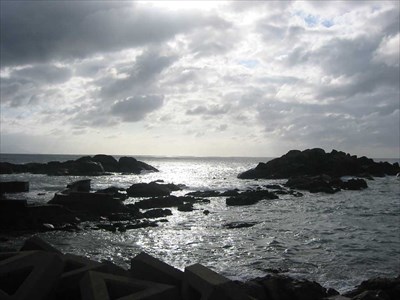
Mejima-Rock and Ojima-Rock
Mejima-Rock and Ojima-Rock
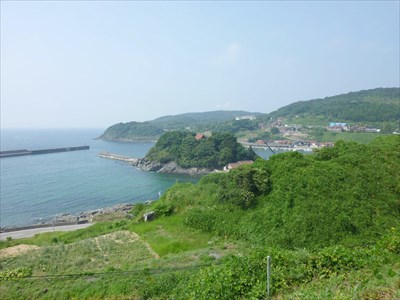
Kamate
This legend is also introduced in "History of Naka-County" by Ikutaro Oshima. Here, Kahime (賀姫) and Koketsuhiko (蘿箇彦)are referred to as Kushirohime (奇色姫) and KushiroHiko (奇色彦) or Koketsuhiko (少毛之彦). It is divided into Kushiro in Mino-County and Kushiro in Naka-County, but in ancient times, men and women generally did not live in the same house, but men went to women's houses. It is said that it was in posterity that men and women helped each other to form a family. It is a remnant of a matrilineal society. This book does not mention the moon Hokamuri (covering the head and cheeks with a towel).
==Who are Kahime and Koketsuhiko?==
KushiroKahime and KushiroAmenoKoketsuhiko are the ancestralsoul of the ancient Kushiro tribe. It is said that the Kushiro tribe went up the Sea of Japan from the country of Izumi via the Seto Inland Sea, landed on the present Kamate Ohama-beach, and settled from western Iwami to central Iwami. The Kushiro tribe is a tribe ranged in Kausga tribe genealogy, and the Ono tribe has also immigrated to Iwami.
A keyhole-shaped tumulus called Sukumo-duka still exists in Kushiro-Town, Masuda City. It is a tomb where the chief of the ancient Kushiro tribe was buried.

A keyhole-shaped tumulus called Sukumo-duka
Regarding the Kushiro tribe, there is KushiroKahime Shrine in Kushiro-Town, Masuda City, and KushiroAmenoKoketsuhiko-no-Mikoto Shrine in Kushiro-Town, Hamada City, each of which is said to enshrine the ancestral spirit of the Kushiro tribe. Both of these two shrines are Iwami Country Shikinai Shrines (the old and officially certified shrines).
There are various theories about how to interpret the names of each god, and attempts are being made to position them in the genealogy of the gods.
First of all, regarding "Kushiro (櫛代)", "櫛" is "comb", but it has the nuance of being "miraculous" and spiritual (奇し). In other words, "櫛" is a honorific title. "Shiro (代)" is said to be a paddy field where rice seedlings are grown.
Next is Koketsuhiko's "櫛色 (kusiro)". "櫛" is a honorific name, "色" is color, that is, "奇し色". In other words, it is a miraculous color.
In "History of Naka-County", Ikutaro Oshima interprets "Kushiro" as "miraculous color (奇し色)". In the Edo period geography book "Iwami Yae Mugura", "Kushiro" is interpreted as "釧", that is, a bracelet. There is also a view that it is a bracelet as an accessory.
Regarding Kahime, there is a theory that "Kahime (賀姫)" is supplemented with the character "忍" to make it "OshikaHime (忍賀姫)". OshikaHime is the niece and wife of AmaTarashiHikoKunioshiHito, the deity of the Ikan Shrine in Shimokou-Town, Hamada City. This theory is persuasive because AmaTarashiHikoKunioshiHito is the ancestral spirit of the Kasuga tribe.
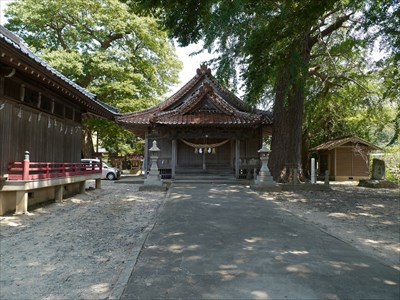
Ikan Shrine

History of Ikan Shrine
On the other hand, there is also a theory that "ga (賀)" in "kahime (賀姫)" is regarded as a misprint of "加 (ka)" and "具 (gu)" and is read as kaguhime (加具姫). Ikutaro Oshima puts a character of "kagu (赫)" on "kaguhime". It is "kagu (赫)" of "Kaguyahime". The nuance is that it is as bright as a fire. In other words, it is interpreted as a princess that shines in a miraculous color (奇色). If you think of Kahime as the goddess of the sun, this view is possible. However, "Kaguhime" sounds unpleasant.
"Hime" stands for "Hi-no-Me (Woman of Sun)", a high-ranking girl.
Koketsuhiko's "蘿 (koke)" is moss or gagaimo (Metaplexis japonica) in a straightforward interpretation. "箇" is "tsu" which means "of". "Hiko" is "Hi-no-Ko (Man of Sun)". It is a good name for boys.
Shinsaburo Shimizu, the deputy chief priest of Izumo Taisha, interprets the sound of "koketsu" as "ogetsu" and interprets it as Hikoogetsu, the child of AmaTarashiHikoKunioshiHito. In fact, the KushiroAmenoKoketsuhiko-no-Mikoto Shrine describes the deity as Hikoogetsu.

KushiroAmenoKoketsuhiko-no-Mikoto Shrine

History of KushiroAmenoKoketsuhiko-no-Mikoto Shrine
In the theory of Ikutaro Oshima, "Koke" is interpreted as "小毛 (koke)". In other words, it means that the body hair is thin. In modern times, it would be equivalent to Neo-Mongoloid.
"天 (Ame)" is 「天孫(a heavenly grandson)」, that is, a god who descended from Takamagahara. There is also an interpretation that she was born locally because Kahime does not have the character "天".
According to the Oshima theory, "Kushiro Kaguhime" was syncretized by Oshikahime. Ikutaro Oshima's view of history is analyzed as the confrontational structure between the Tenson tribe named Himehiko tribe and Tsuchigumo, and in modern times the composition of the Yayoi and Jomon people, and the differences in their appearances cause surprises and emotional threats when they first come into contact with different races. Oshima interprets it as a nuance of "miraculous color (kushiro)", that is, "a strange man" and "a strange woman". The publication year of "Naka-County Magazine" was in the Taisho era, and Ikutaro Oshima's historical view is probably a unique historical view before the war.
==goddess of the Sun and god of the Moon==
Ojima and Mejima are only a few hundred meters away from Kamate's Ohirume Shrine. As the name suggests, Ohirume Shrine enshrines Amaterasu (Ohirume-muchi), the supreme goddess of the sun, as a deity. Local historians have considered whether KushiroKahime was originally enshrined there, or whether KushiroKahime was the goddess of the sun.
The "Hokamuri" legend of the Koketsuhiko, which symbolizes the filling and lacking of the moon. To understand KushiroKahime as a KushiroKaguhime (奇色赫姫). Kamate Ohama-beach is said to be the landing point of the Kushiro tribe. Furthermore, the composition of the goddess of the sun and the god of the moon emerges from the existence of the Ohirume Shrine, which is located in a land related to these two gods.
According to "Masuda City Magazine", when KushiroKahime Shrine moved from Ohama to Kushiro, it solicited a higher-ranked Ohirume Shrine. However, it should be noted that the contents of the Ohirume Shrine's biography are different.
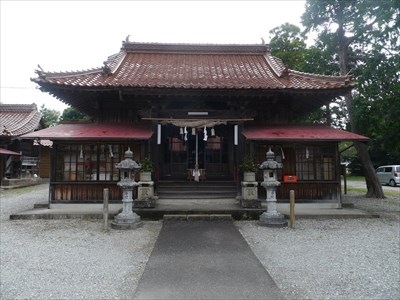
Kushiro-Kahime Shrine

History of Kushiro-Kahime Shrine
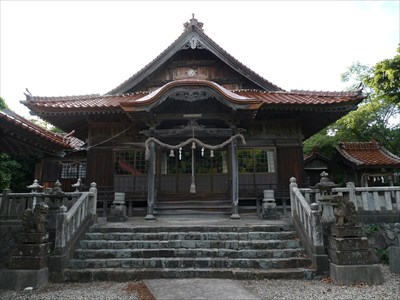
Ohirume Shrine
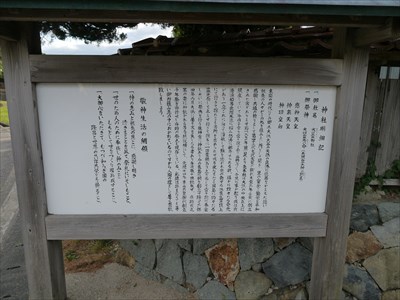
History of Ohirume Shrine
It is thought that when this KushiroKahime Shrine moved from Ohama to Kushiro, it enshrined Amaterasu, which has a higher divinity. In other words, it is possible that there was an alternation of the goddess of the sun.
I don't know if the theory of interpreting KushiroKahime as the goddess of the sun is valid. "Kahime" sounds harmony than "Kaguhime", and I feel like They are thinking too much. I am personally fascinated by the interpretation of a miraculously shining princess.
==Shinto ritual==
At KushiroKahime Shrine, the lion dance ritual, sumo (draw sumo) ritual, and needle memorial service (needle picking) ritual are known. In the sumo ritual, the villages fought over where to relocate KushiroKahime Shrine, and they decided to compete in sumo, but they couldn't win or lose in the draw. In other words, Kahime is a sumo-loving goddess. The needle-picking ritual said that the old woman who arbitrated the quarrel lost her important needle and searched for the needle like crazy, and the oracle said, "Because needlework is a woman's way, take care of it." It imitates the story.
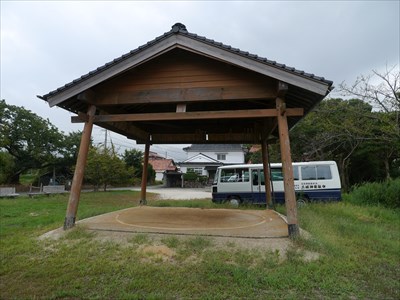
Sumo ground of Kushiro-Kahime Shrine
==Kagura==
There is a creative performance of Iwami Kagura called "Ryujin", and KushiroKahime appears. They say that a dragon appears in front of KushiroKahime, who picks up the dragon god's gem in the sea, and instead of returning her gem, the dragon dances in the sky. Probably a performance performed by some companies in Masuda City, I have never seen it.
==Digression==
In August 2008, I went to Kamate and photographed Ohirume Shrine, Ojiima-rock, and Mejima-rock. Then I went to Kamate again in August 2018. As you can see by comparing the above pictures, tetrapods were attached near Ojima and Mejima. It is the destruction of the landscape.
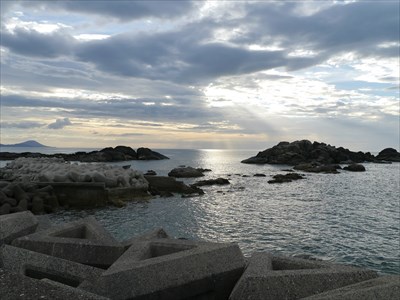
My maternal grandfather came from Kushiro-Town, Hamada City, and maybe a drop of ancient Kushiro tribe's blood may be flowing.
==References==
- *『石見鎌手郷土史』(矢富熊一郎, 島根郷土史会, 1966)
- *『那賀郡史』(大島幾太郎, 大島韓太郎, 1970)pp.112-113
- *『那賀郡誌(復刻版)』(那賀郡共進会展覧会協賛会/編, 臨川書店大正5年発行, 1986)pp.65-71
- *『益田市誌 上巻』(益田市誌編纂委員会/編, 1975)
- *『保存版 島根県の神楽』(監修 石塚尊俊, 郷土出版社, 2003)
- *『角鄣経石見八重葎』(石見地方未刊行資料刊行会/編, 石見地方未刊行資料刊行会, 1999) *朝山晧「石見國式社考」(五・完)『神光』第十二号 22p